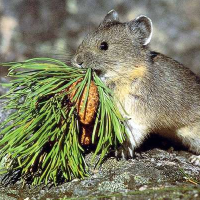50,000 Plant and Animal Species Threatened by Loss of Their Natural Habitats from Climate Change
 American pika at risk because of climate change's increased heat (photo: U.S.)
American pika at risk because of climate change's increased heat (photo: U.S.)
Climate change this century is likely to jeopardize the habitats supporting tens of thousands of animal and plant species, scientists say in a new study.
Researchers in the United Kingdom examined more than 48,000 species and concluded that 55% of common plant species and 35% of common animal species could lose half of their living space by 2080 if carbon dioxide (CO2) emissions continue at their current pace. That, in turn, could put the survival of the species at risk.
Much of the climate change research to date has focused on its effect on rare species. The fact that common animal and plant species will be put at risk is cause for even greater alarm.
Predictions are that increases in CO2 will result in the Earth’s atmosphere warming by more than seven degrees Fahrenheit by 2100, compared with CO2 levels during the 18th century before the Industrial Revolution.
The study’s investigators, based at Britain’s University of East Anglia, believe the species most at risk are amphibians, plants and reptiles. They also say the regions that are the most vulnerable to habitat changes are Sub-Saharan Africa, Central America, Amazonia and Australia.
The study suggests that the expected loss of these species could be reduced by 60% if there was a substantial global reduction in CO2 emissions that began immediately. That would require carbon emissions to peak in 2016 and decline by 3-4% every year thereafter. The odds of this happening are not considered likely.
-Noel Brinkerhoff, Danny Biederman
To Learn More:
Unprecedented Speed of Global Warming to Impact Half of All Plants and a Third of Animals (Agence France-Presse)
Common Plants, Animals Threatened by Climate Change, Study Says (by Neela Banerjee, Los Angeles Times)
Quantifying the Benefit of Early Climate Change Mitigation in Avoiding Biodiversity Loss (by R. Warren, J. VanDerWal, J. Price, J. A. Welbergen, I. Atkinson, J. Ramirez-Villegas, T. J. Osborn, A. Jarvis, L. P. Shoo, S. E. Williams, and J. Lowe; Nature Climate Change) (abstract)
Acidification of Oceans Caused by Climate Change to Last Tens of Thousands of Years (by Noel Brinkerhoff, AllGov)
Climate Change Sends Big Agribusiness Companies North to Buy Land to Plant Grain (by Matt Bewig, AllGov)
Can Cryogenics Save Endangered Species? (by Noel Brinkerhoff, AllGov)
- Top Stories
- Unusual News
- Where is the Money Going?
- Controversies
- U.S. and the World
- Appointments and Resignations
- Latest News
- Trump to Stop Deportations If…
- Trump Denounces World Series
- What If China Invaded the United States?
- Donald Trump Has a Mental Health Problem and It Has a Name
- Trump Goes on Renaming Frenzy






Comments